Scale Insects Are Getting Fat
I have a Fuyu persimmon in front of my house. It’s 10 years old and highly productive. The fruits are very delicious and the deep orange-red leaves bring some degree of excitement to a yard that lacks any fall color by the virtue of being on the coastal plains of South Carolina. Its taste and productivity are famous among our cousins—so much so that Rod and Eliza are determined to graft a bunch of them. (Bless their hearts, They still haven’t had any success after two tries. Maybe the third time is the charm ...?) And it has nine lives. Well ... six since it lost three of the nine lives after being run over by my good friend David within one year of transplanting.
The persimmon tree has few pests. The clay-colored leaf beetles and persimmon psyllids damage some new leaves in the spring, but they don’t seem to impact fruit yield or need me to do something about them. There are also some soft scales, which I think are European fruit lecanium.
These soft scales are getting fat and more noticeable since last week. Hence, today’s main message: Soft scales are getting fat so start making management plans for them.
There aren’t many of these plump females, so I just handpick them whenever I see them. You won’t believe the multitude of eggs that poured out of a couple of scales I picked last weekend!
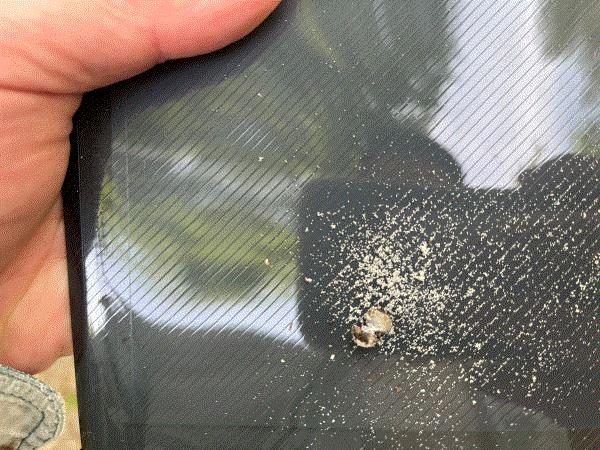
The reproductive capability of soft scales doesn’t surprise me. In a research paper published almost 10 years ago, my former graduate student Ernesto Robayo reported that an average female in a mixed population of European fruit lecanium and oak lecanium (these two species are almost indistinguishable as adults) produces more than 1,000 eggs.
In another study, they found that peach scale females produce an average of 1,361 eggs and frosted scale females produces an average of 387 eggs. Brown soft scales produce 582 to 725 crawlers (i.e. the first-instar, dispersing nymphs) over one month in another study.
Despite the variations in fecundity (i.e. the number of eggs) among species and even within a genus, we can conclude that soft scales produce a lot of eggs. I hope y’all understand now why a scale insect population can get out of control very quickly if some kind of restriction or regulation (either by us or by nature) isn’t imposed on population growth.

Crawler Hatching Time
The best time to manage scale insects is when the eggs are hatching or when the females are producing babies (for species that don’t go through the egg stage). The hatchlings or babies are called crawlers because this is also the stage of life when the youngsters disperse or crawl away from their dying mothers and bickering, elbowing siblings to new feeding sites.
Crawler is also a life stage important to scale insect management. More than 90% of crawlers don’t survive to adulthood because of natural causes, such as weather or predators. The surviving 10% can still produce enough offspring to cause a population boom, so the first reason for controlling crawlers is to reduce future population growth.
The second reason for controlling crawlers is because it’s vulnerable to many mortality factors or control tactics compared to other life stages. Without a wax layer to protect them from direct contact, the crawlers can easily be killed with most insecticides.
So when do crawlers appear? The answer depends on what species we’re talking about. There are close to 9,000 species of scale insects in the world and about 1,100 of them reside here in North America. A few years ago, I conducted a review of scale insect specimen identification records from throughout the United States with the help from Bill Klingeman of the University of Tennessee and a few other colleagues. We identified the armored scale, soft scale, mealybug and other scale insect species that were ever identified on ornamental plants and outlined the Top 20 species from each group. (Go HERE for a copy of the paper.)
One of the most important conclusions is that by knowing the Top 20 species in each scale insect family or group (for a total of 51 species and nine genera) you’ll be able to identify 87% of all scale insect samples you come across. Knowing 60 taxa instead of 1,100 species? I’ll take that lower learning curve!
Of course, you can also send samples to your favorite diagnostic labs. You may not get conclusive species identification even if you send in samples, however, because the expertise of scale insect identification is dwindling. Scale insect identification is a tedious, thankless job that many graduate students aren’t interested in learning about and become proficient in. No graduate students, no future experts.
Table 1. The numbers of generations per year and generalized crawler emergence time of the 10 most commonly found armored scale species in the South.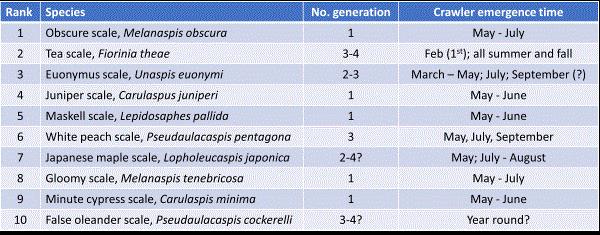
Table 2. The numbers of generations and generalized crawler emergence time of the 10 most commonly encountered "soft" scales (including soft scales, felt scales, kermes scales, etc.) in the South.
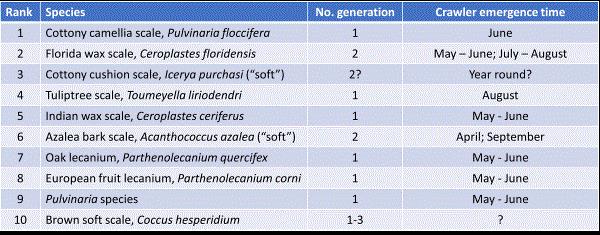
You can start researching life history information now that you know what species you’re dealing with. There are two pieces of information you need to get—how many generations the species has and when the crawlers of each generation emerge. Knowing how many generations will help you budget the spray frequency (I usually recommend two sprays, spaced 14 days apart, per generation). Knowing when crawlers emerge will tell you when to start spraying.
Literature research may sound simple, especially with the help of AI, but there's a lot of scattered information, which can drive even the most patient and diligent among us up the wall. I suggest focusing on finding information specific to your area; for that, your local extension service is a good place to start.
If information isn’t available for your area, use what you can find in the surrounding states as a guide. Information for soft scales is collected in a review paper written by Ernesto and me (go HERE for the paper), but similar reviews for armored scales hasn’t been conducted. (Like many of my “projects,” I had a plan to do it, but never find the time to.)
I've listed the voltinism (i.e. the number of generations annually) and generalized crawler emergence times of some of the most common species in the two tables above. Reach out to me if you need more information (I have longer tables than what’s presented above) or assistance in identifying or understanding scale insects.

Methods of Monitoring Crawler Emergence
I hope the two tables in the previous section are helpful. Note that the months of emergence are generalized. This time can change depending on the temperature, which fluctuates from year to year. So the listed time should be used as a guide instead of the absolute rule for when to make insecticide applications.
Crawler emergence time can also be approximated using degree-day models or plant phenological indicators. Ernesto’s paper also has information about these approximation methods in relation to soft scale crawler emergence time.
It doesn’t matter what method you use—calendar dates, degree-day models or plant phenological indicators—they only give you a guess of when crawlers may emerge, not precisely when they emerge. So you still need to look for the crawlers and confirm that they’re indeed appearing before making insecticide applications.
You can look for them visually. Find yourself an infested tree and visit the tree regularly about a couple of weeks or so before the calendar date or when the degree-day models or plant phenological indicators indicate emergence.
Alternatively, you can flip over a few fat female scale insects and see if eggs have been produced or if eggs are hatching. You can start treatment if you find crawlers or continue monitoring if not.
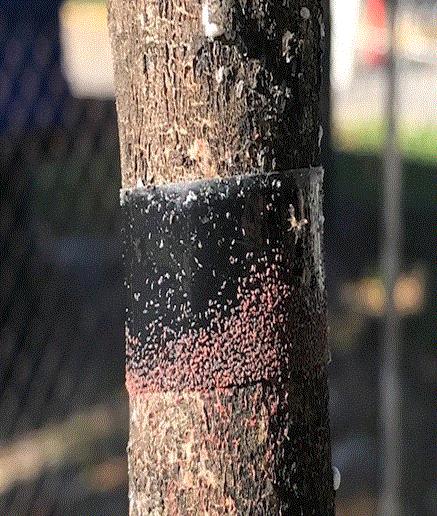
Purplish crape myrtle bark scale crawlers stuck to a sticky trap wrapped around an infested crape myrtle trunk.
My favorite monitoring method is to use a sticky band. I wrap electrical tape, sticky side out, around the branches of a few infested trees a couple of weeks before the calendar date or as the date predicted by the degree-day model approaches. I then check on the tape once a week and start treatment when crawlers are trapped on the tape. I've done this quite successfully for several species that feed on the trunks and branches, such as crape myrtle bark scale (pictured above). This method can also be used on species that feed on the leaves, but I think visual inspection may be most effective for leaf-feeding species.
In the past, I also suggested putting an infested twig in a glass jar, leaving the jar in the shade and checking on it regularly to see if crawlers are crawling inside the jar. I think this method will work well as long as the jar isn’t left to dry up or become moldy in the wrong storage place or it’s completely forgotten.

JC's Typical Recommendations for Scale Insects
Quite a few insecticides are registered to manage scale insect infestations. Go HERE to get a poster I prepared on finding an insecticide registered for managing different pests in greenhouses and nurseries. Which insecticide should you pick?
I know neonicotinoids have a bad rap, but nothing beats this group in terms of efficacy against scale insects. They’re also versatile—you can foliar spray, basal trunk spray, drench, inject or use a granular formulation (if available) of neonicotinoids. The ability to apply by drench, trunk spray and injection makes neonicotinoids a valuable tool in treating large trees.
Other systemic insecticides can also be used, but they typically take longer to translocate to the canopy where the scale insects are feeding, so it may take longer for the non-neonicotinoid systemic insecticides to work. Know the difference in the speeds of translocation and activity between neonicotinoids and other systemic insecticides and account for that difference when timing the application. Typically, one drench or injection treatment is needed per year.
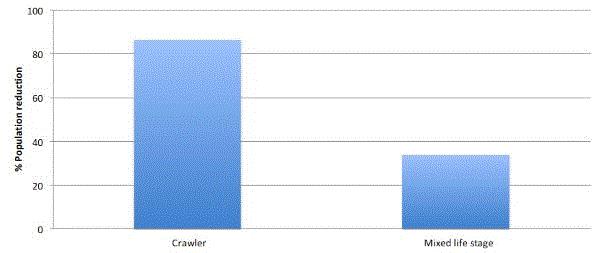
Why do you want to target crawlers in a scale insect management program? Because crawlers are easier to kill than other life stages, such as in this study (conducted by me). When sprayed twice with 2% horticultural oil at 14-day intervals, a citrus mealybug (which is technically a scale insect) population consisted of crawlers suffered higher mortality than a population consisted of all life stages.
Systemic insecticides don’t work on adults. In fact, no insecticide works particularly well against adults, which are protected by a thick layer of wax or shell. Also, in my experience, systemic insecticides don’t perform well when used against scale insect species that are feeding on trunks and branches.
For species that feed on woody tissue, you’ll have to spray. Again, there are a lot of insecticides to choose from. When I treat my own trees, I go with insecticidal soap, horticultural oil, insect growth regulators (IGR; particularly buprofezin or pyriproxyfen) or a tank mix of horticultural oil and IGR.
A study by Carlos Quesada and Cliff Sadof suggested that horticultural oil may be more effective against armored scales, whereas insecticidal soap may be more effective against soft scales. The tank mix of oil and IGR is effective against both groups. I suggest making two applications (two weeks apart) against each generation of crawlers. Again, targeting crawlers will be more effective than targeting other life stages (see the graph above).
You might be wondering why I only include soap, oil and IGRs in my recommendation. That’s because these products generally have low impacts on natural enemy populations.

Don't Forget About Biological Control
Biological control is important for scale insect management. I find plenty of ladybeetle larvae feeding on crape myrtle bark scales.
In a paper, Ernesto and our colleagues reported 21 parasitoid species and 12 predator species attacking lecanium scale populations in Georgia, North Carolina, South Carolina and Virginia. All of these natural enemies are naturally occurring. In South Carolina, parasitoids are responsible for 59% to 92% reduction in lecanium scale nymphs and 27% to 84% of the adult populations. There's a large body of research from Steve Frank’s lab at North Carolina State University demonstrating the importance of biological control of scale insect populations in urban areas and the consequences of climate change and heat island effect on this free, natural form of pest control.
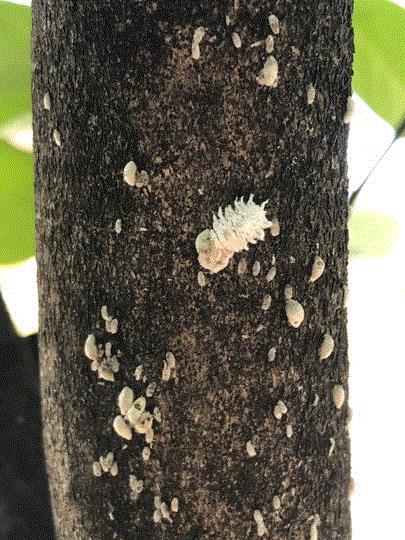
A ladybeetle larva (the larger fluffy white thing) is chowing down on crape myrtle bark scales (the smaller fluffy white thing).
In scale insect management, the worst thing you can do is to mess up biological control. Hence, I elected to use oil, soap and IGRs in lieu of other insecticides (such as organophosphates and pyrethroids) that may be effective against scale insects, but interfere with the activities or survival of natural enemies.
Happy de-scaling this season!




See y'all later!

JC Chong
Technical Development Manager at SePRO
Adjunct Professor at Clemson University
This e-mail received by 27,847 subscribers like you!
If you're interested in advertising on PestTalks contact Kim Brown ASAP!